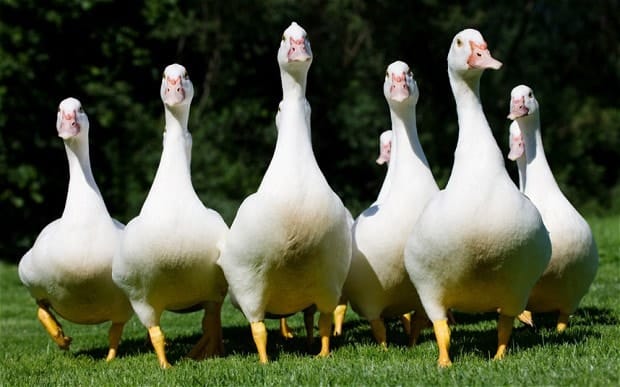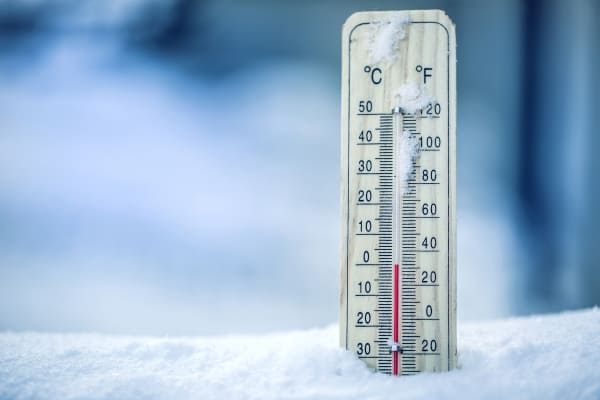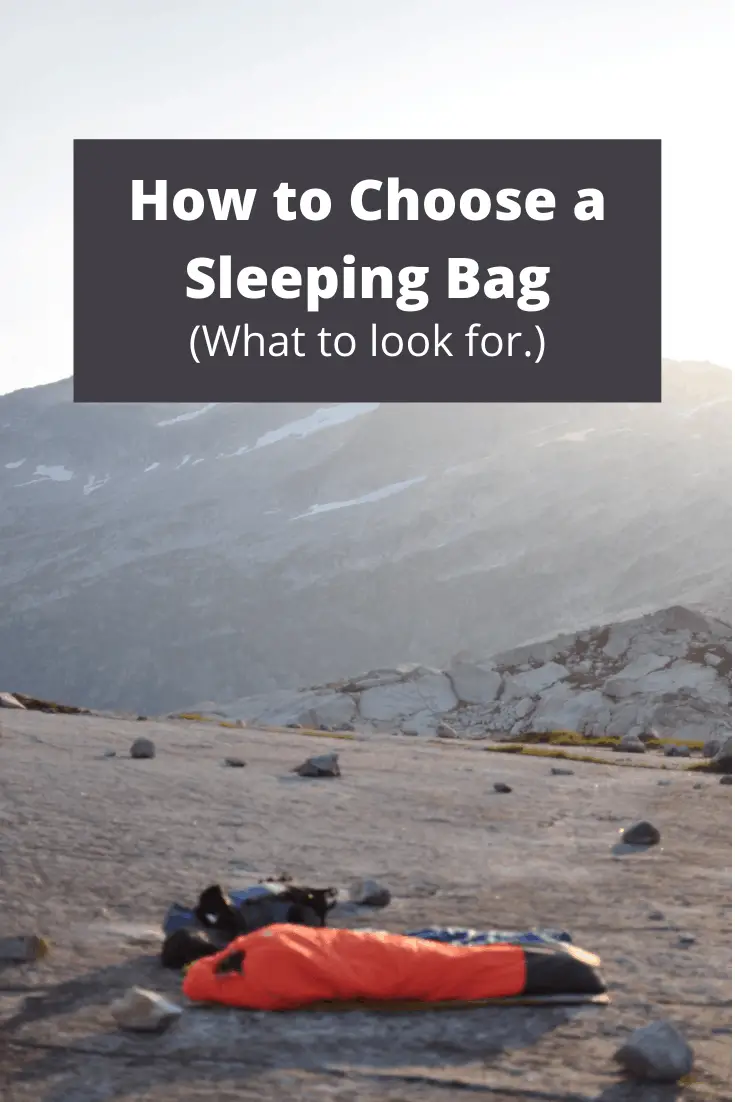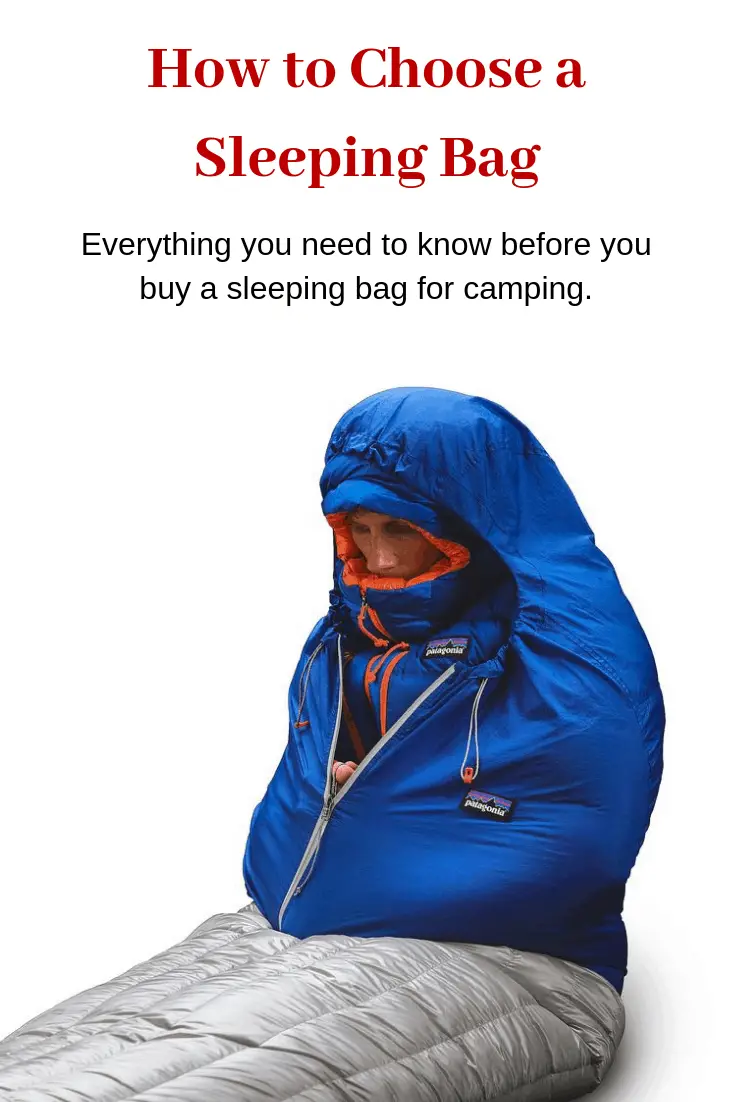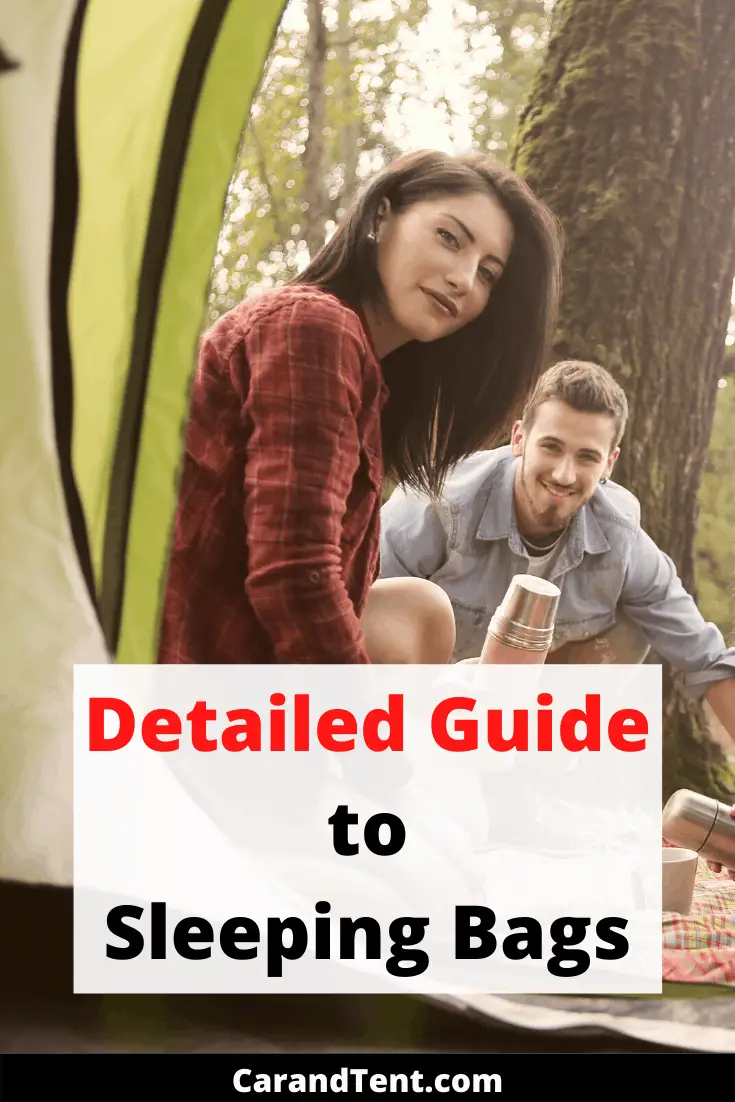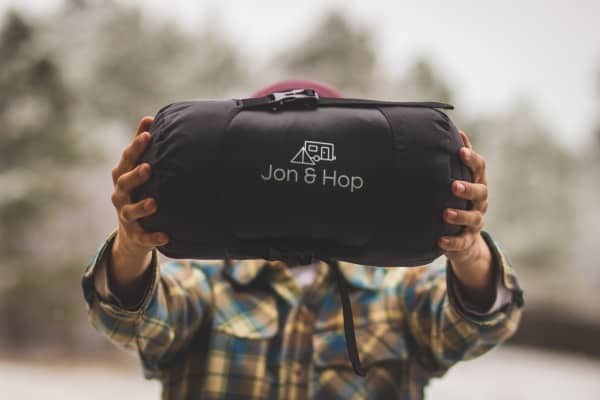
As a camper, knowing how to choose a sleeping bag is one of the best skills you can have. In this article, we’ll go over everything you need to know before you buy a sleeping bag.
We’ll cover: how sleeping bags work, what temperature ratings really mean, the different types of sleeping bags you can buy, the different methods of sleeping bag construction, and why you might want to consider one type of sleeping bag over another.
Table of Contents
How Do Sleeping Bags Work
A sleeping bag keeps you warm by trapping your own body heat and surrounding you with a protective shell of warm air. Typically, the more insulation a bag has, the warmer it will keep you.
This being said, the design of a sleeping bag can also play a big part in keeping you warm. For instance, mummy sleeping bags are designed to be more efficient than traditional ones. This means that a well-designed sleeping bag may help keep you warmer than one with more insulation.
Remember, the human body has an internal temperature of around 98 degrees Fahrenheit. This high temperature is created by our metabolisms and while we might cool down slightly when we sleep, we’re still pretty hot. Trap this heat inside of a sleeping bag and it will help keep you warm throughout the night.
Let’s take a look at how sleeping bag insulation materials can be used to help keep us warm.
Sleeping Bag Insulation Materials
Sleeping bags are normally made from down fill or synthetic fill. Down has better insulating properties than synthetic materials and can often be compressed more easily. This means that all things equal, a down fill sleeping bag will use less space in your backpack and will keep you warmer than a synthetic one will.
The downside to down is that it does not work well in wet conditions. While a synthetic sleeping bag can still help you keep warm even if it’s wet, a down sleeping bag will not.
Also, a synthetic sleeping bag will typically dry out much quicker than a down-filled sleeping bag will.
This is especially important information for people who will be backpacking with their sleeping bag in wet or even humid conditions. When you’re out in the wilderness, a dry sleeping bag can be the difference between life and death.
If you think you’ll be in wet conditions, you may want to consider checking out my review on the military sleeping bag. I used one in the Army and ended up buying my own after my service term was completed. This sleeping bag has a waterproof Gortex outer shell that protects it from the water.
What exactly is down?
Down filling is really just a bunch of small and light feathers combined together to fill the inner part of a sleeping bag. The feathers most commonly used are duck or goose.
What makes one down sleeping bag better than another? Higher quality down will have a higher loft rating. The higher the loft, the better the down is at insulating a bag. In layman’s terms, loft is the fluffiness of the down. The more fluffy the down is, the higher the loft is, and the better the down is at trapping heat.
The reason for this is that higher loft fills have larger air gaps between the down. Air gaps catch and trap the hot air coming off of your body and use it to help insulate you with warm air.
In addition to the loft rating, you’ll also want to look at the construction of the sleeping bag. Some sleeping bags will use mesh partitions which help keep warm air from escaping the bag. This type of construction is known as box wall construction and is far superior to typical sewn-through construction.
When buying down, you may run across the term “fill power”. Fill power is the amount of space an ounce of down fill will take up in cubic inches when it is allowed to reach its full loft potential. Again, think fluffiness. The more the down fill expands and the more volume it takes up, the better it is. Downs with high fill power ratings are warmer and more durable than downs with lower fill power ratings.
Goose or Duck?
Duck…duck…duck……goose! A goose-down sleeping bag is usually better than a duck-down sleeping bag. The reason for this is that goose down provides better insulating properties, (higher loft rating) than a duck down and can keep you warmer with less weight.
Goose Down
Goose down is taken from the goose. The goose is a migratory bird that lives up to 20 years and can fly up to 40 miles per hour. A Canadian goose averages about 9 pounds. Because geese are large birds, they have large feathers that are great for using as down fill.
Advantages of Goose Down Over Duck Down
- Goose down has a higher fill power.
- Goose down is softer than duck down.
- A goose-down bag is less likely to suffer from odor issues.
- Goose down tends to be more durable than duck down.
In addition to having a higher fill power, goose down is softer than duck down which makes it better to sleep on. This is why it is usually more important to have goose down in a sleeping bag than it is to have goose down in a jacket.
Goose down is more durable than duck down which is especially important for people who will be compressing their sleeping bags on a regular basis. This means that if you use your sleeping bag for hiking you’ll be better off buying a goose down bag over a duck down bag.
Another benefit that isn’t talked about often is that duck down can sometimes have odor problems that goose down does not have. This is because ducks have a diverse diet that includes fish eggs, frogs, and other animals while geese subside mostly off of grass and other plant materials. A good duck down should be cleaned well enough to eliminate this issue but often times it is not.
Duck Down
In case you haven’t guessed already, duck down is taken from the duck. Ducks are farmed for their meat as well as their feathers. Because of this, the price of duck fill can actually dive down during bird-flu scares as ducks are culled in mass without actually being eaten.
Advantages of Duck Down Over Goose Down
- Duck down costs less.
- High-quality duck down can have a higher fill power than goose down.
Duck down is more abundant than goose down and as a result, is usually a lot less expensive to buy. Also, high-quality duck down can actually be better than lower quality goose down. The reason for this is the higher fill power of goose down comes from the fact that goose feathers are larger. If you only use the large feathers of a duck, you end up with a high-quality duck down.
Compare the fill power of large duck feathers to the fill power of small goose feathers and the duck feathers will come out on top. This makes buying a duck down sleeping bag tricky as the duck might actually be better than the goose sleeping bag but you won’t know unless you’ve actually had a chance to measure its fill power.
Synthetic Down
Synthetic down can be made from a variety of materials. Polyester is one of the oldest and most common forms of synthetic down but you can find it in more modern materials like microfiber and Gortex. Oftentimes, manufacturers will use different materials within the same sleeping bag. They do this so that the bag can take advantage of the different properties of each type of insulating material.
Advantages of Synthetic Down
- Less maintenance.
- Better in wet conditions.
- More durable.
- Less expensive.
- Lighter.
- Animal-friendly.
Because synthetic materials vary so wildly it is hard to accurately compare synthetic down to goose and duck down materials.
Generally, you’ll find that synthetic bags are less maintenance and hold up better than their animal counterparts. If you’re concerned about killing animals you’ll be happy to know that synthetic materials don’t involve them and you’ll probably pay less too.
All this being said, some sleeping bags with synthetic fills aren’t that great and they are less durable than goose and duck-filled bags and they may even be more expensive. For this reason, you may want to look at the temperature ratings of the different fill materials.
How to Choose a Sleeping Bag by Temperature Rating
Different sleeping bags will have different temperature ratings assigned to them. However, you should keep in mind that unless the rating is based on the EN 13537 rating system, then this rating is assigned to it by the manufacturer.
Also, everyone is different, so while one sleeping bag might keep person A completely warm at night, it might leave person B shivering all night.
A good rule of thumb for three-season campers is to find a bag that is rated down to 0 degrees Celsius or 32 degrees Fahrenheit. Also, if you know you get cold easily, buy a sleeping bag with a warmer rating and vice versa.
An Attempt at Standardization
Back in 2005, The European Committee for Standardization came up with a rating system to help campers choose sleeping bags. Their rating system is known as the EN 13537. Manufacturers do not have to conform to these standards, but if they do decide to use them, their bags will be independently tested by a standard laboratory test.
The EN 13537 uses a manikin with heat sensors in it to measure sleeping bags using 4 different criteria.
Extreme – This is the minimum temperature that a standard woman can remain for 6 hours without risking death. However, a person could still get frostbite, so it’s certainly not the ideal situation.
Lower Limit – This is the temperature that a man can sleep in for 8 hours in a curled-up position without waking up from being too cold.
Comfort – This is the temperature that a standard woman can sleep comfortably in without having to curl up.
Upper Limit – This is the temperature that a standard man can sleep in without getting excessively sweaty. This rating assumes that the sleeping bag has both hood and zippers open and that the camper’s arms are outside of the sleeping bag.
I’d stay away from using this rating as a wet sleeping bag can be very dangerous and who is to say you won’t move your arms inside of your bag while you’re asleep.
Standard Man – 25 years old – 5’7” – 161 pounds
Standard Woman – 25 years old – 5’2” – 132 pounds
Obviously, not everyone is this age, height, or weight, so your mileage may vary, but at least you’ll have a standard gauge to base your search on.
Fitting a Sleeping Bag
Remember that a sleeping bag works by trapping warm air around you. The snugger a sleeping bag is, the easier it is to keep warm. The reason being, you’ll have less space for outside air infiltration with a snug sleeping bag.
This being said, you don’t want a sleeping bag that is so tight that you’re uncomfortable. Here are the areas where you’ll want to pay attention when fitting a sleeping bag.
Length – Sleeping bags usually come in 3 lengths – long, regular, and sometimes short. These aren’t always standardized, so you’ll want to check the manufacturer’s charts to see which length would work best for your height.
Shoulder and Hip Girth – A sleeping bag will come in different widths at both the hip and the shoulders. Rather than taking measurements, it is usually better to try a few different widths. Trying out a few different widths will ensure that you know what sizes are most comfortable for your body.
Weigh-ins
Another issue to consider when buying a sleeping bag is the size and weight of the bag. Car campers won’t have to worry so much about size and weight considerations, but backpackers will. Bags that compress really well will fit in your backpack better than bags that do not.
Also, if you intend to backpack a long distance to your camping destination, you may need to consider reducing your backpack’s weight by going with a lighter sleeping bag. Often-times lightweight backpackers will try to get their sleeping bag weight down to about two or three pounds.
Just make sure you don’t risk getting too cold just to save yourself from carrying an extra pound of weight in your backpack. Remember, a backpack will feel much heavier in the morning after you’ve been up shivering all night.
Types of Sleeping Bags to Choose From
There are many different styles of sleeping bags to choose from, but the two main ones are hooded sleeping bags and hood-less sleeping bags.
Hooded Sleeping Bags – AKA Mummy Sleeping Bags
Hooded sleeping bags are also known as mummy sleeping bags. They have hoods on them so that the sleeping bag covers your body as well as your head, neck, and face. It is usually shaped so that it fits more snuggly against your body when compared to its hoodless sister.
Here are the advantages of mummy sleeping bags.
- Designed to be warmer.
- Usually easier to pack.
- Full protection from the elements.
A hooded sleeping bag covers your head and part of your face. Since a person loses much of their body heat through their head, this type of bag can often be warmer than its hoodless counterpart. Additionally, these bags fit tighter than hoodless sleeping bags and can often trap air more efficiently. This leads to an increase in warmth without the need for additional fill power.
These bags are usually lighter and thinner which makes them easier to pack. This makes them great for backpackers who want a cold-weather sleeping bag to take with them on their trek.
The design of the bag also gives it the ability to protect a person from other elements besides the cold.
For instance, my sleeping bag has an outer shell that makes it waterproof. I can literally lay in a puddle of water in this sleeping bag without getting wet. This wouldn’t be possible without the hood as water would easily be able to infiltrate the bag through the open area above my shoulders.
Hoodless Sleeping Bags
Hoodless sleeping bags do not have hoods and they often do not fit as snuggly as hooded sleeping bags. These bags are older than hooded sleeping bags and are sold more often than them as well.
Most bags are completely rectangular but you can buy ones that are tapered towards the feet. This makes the bag warmer and helps to reduce the size and the weight of the sleeping bag. If you’re buying a hoodless sleeping bag for backpacking, you’ll probably want to choose one that is tapered.
Advantages of Hoodless Sleeping Bags
- Less condensation.
- Less restrictive.
- Less expensive.
- More comfortable.
- More versatile.
With a hoodless sleeping bag, you get less and this just might be a good thing. You’ll get less condensation, less restriction in your movements, and you’ll pay less too.
With a hooded sleeping bag, all you have to do is turn your head the wrong way and you’ll end up breathing into your sleeping bag. This can quickly cause condensation and you can end up with a wet sleeping bag. With a hoodless sleeping bag, you actually have to pull the sleeping bag up over your head in order to have this same problem.
Because hoodless sleeping bags are less restrictive, their often more comfortable to sleep in. Not only this, but you can actually buy double sleeping bags so you and another person can sleep together without any barriers between the two of you.
Car campers generally choose hoodless sleeping bags over hooded sleeping bags but hooded sleeping bags tend to make better dual-purpose bags.
Specialized Types of Sleeping Bags
There are a few types of sleeping bags that are meant for specific situations. These bags are worth taking a look at when you’re doing certain specialized activities that may require a specialized bag.
Here are some of the sleeping bags you may want to consider:
- Mountaineering sleeping bags.
- Ultralight sleeping bags.
- Sleeping bags with built-in pads and pillows.
Mountaineering Sleeping Bags
A mountaineering sleeping bag is constructed in the most efficient way possible. It is built to provide warmth for extreme weather conditions and it is also built to be as light as possible for climbers.
This is accomplished by dramatically tapering the sleeping bad throughout its width so that excess material can be cut from the bag. Because the bag is tapered it also reduces airflow throughout the bag and reduces the opportunities that cold air might have to infiltrate the sleeping bag’s interior.
You can find sleeping bags for mountaineering that are rated down to temperatures of -40 degrees. These bags are perfect for people camping in cold climates but wouldn’t be very useful in mild ones.
Ultralight Sleeping Bags
Ultralight sleeping bags are usually reserved for people camping in mild weather. They are also employed by people trying to keep their base weight down to a minumim. These bags can often weigh in at less than 1 pound but they won’t protect you in temperatures below 40 or 50 degrees.
The Best Base Weight for Backpacking – Exploring Backpack Weights
Backpackers hitting the trails in the summer will often camp with this type of sleeping bag. Also, some people will buy them to throw into their daypacks so that they’ll have something in case they end up getting lost or stranded while out hiking.
Sleeping Bags with Built-in Pads
Some sleeping bags come with pads, pillows, and even air mattresses built right into them. These sleeping bags are usually heavy and bulky and are not very useful for backpackers.
Car campers can often take advantage of these types of sleeping bags as they neatly wrap several items into one and make it a bit more difficult to forget things. The only issue is that if you forget or lose this sleeping bag you’ve essentially lost several pieces of gear at once.
Tying it All Together
Each sleeping bag has its advantages and disadvantages. The main question to ask when choosing a sleeping bag is, does it suit my needs? You’ll want to choose the sleeping bag that keeps you warm at night and fits the use you’ll be putting it to.
Taking your sleeping bag backpacking? Buy the lightest sleeping bag that fits both your temperature rating and your budget.
Going car camping? Buy the most comfortable sleeping bag that fits the climate you’ll be camping in and your budget.
Related Questions
How To Backpack with a Sleeping Bag
The best place to put your sleeping bag when backpacking is at the bottom of your sleeping bag. This will help protect it from the weather while keeping it out of the way of other items that you may need to have access to during the day.
This being said, sometimes your sleeping bag will be too large to fit in your backpack with the rest of your gear. In this case, you may need to lash your bag to the outside of your backpack. You can do this through the use of sleeping bag straps.
Strap the bag tightly to the bottom of your backpack using the straps. Personally, I try to avoid packing so much that I have to do this as I do not like carrying my sleeping bag outside of my pack. When I go backpacking I’ll bring the smallest sleeping bag I own and the largest backpack I own all in an effort to keep everything safely in the backpack.
How to Store a Sleeping Bag
A sleeping bag needs to be stored carefully or it can become less effective. Before you put your sleeping bag away, make sure you clean it and dry it out. This will ensure that mold and mildew does not build up inside your bag and that it does not hold any unpleasant smells.
Here are some items you might want to use to store your sleeping bag.
- Stuff sacks.
- Compression bags.
- Dry bags.
A stuff sack is a large bag with a drawstring top. It reduces the amount of space your sleeping bag takes up without compressing it. This bag can be used to store your sleeping bag whenever it is not in use.
A compression bag, on the other hand, compresses your sleeping bag to the smallest size it is capable of being. It saves space and is great for backpackers and even car campers with limited space.
This type of bag should never be used for long-term storage as it can alter the loft of a sleeping bag and make it less effective.
A dry bag is great for keeping sleeping bags as well as other gear dry. Use these bags when canoe, kayak, or boat camping. They’ll help to keep your bag dry until you’re ready to use it.

